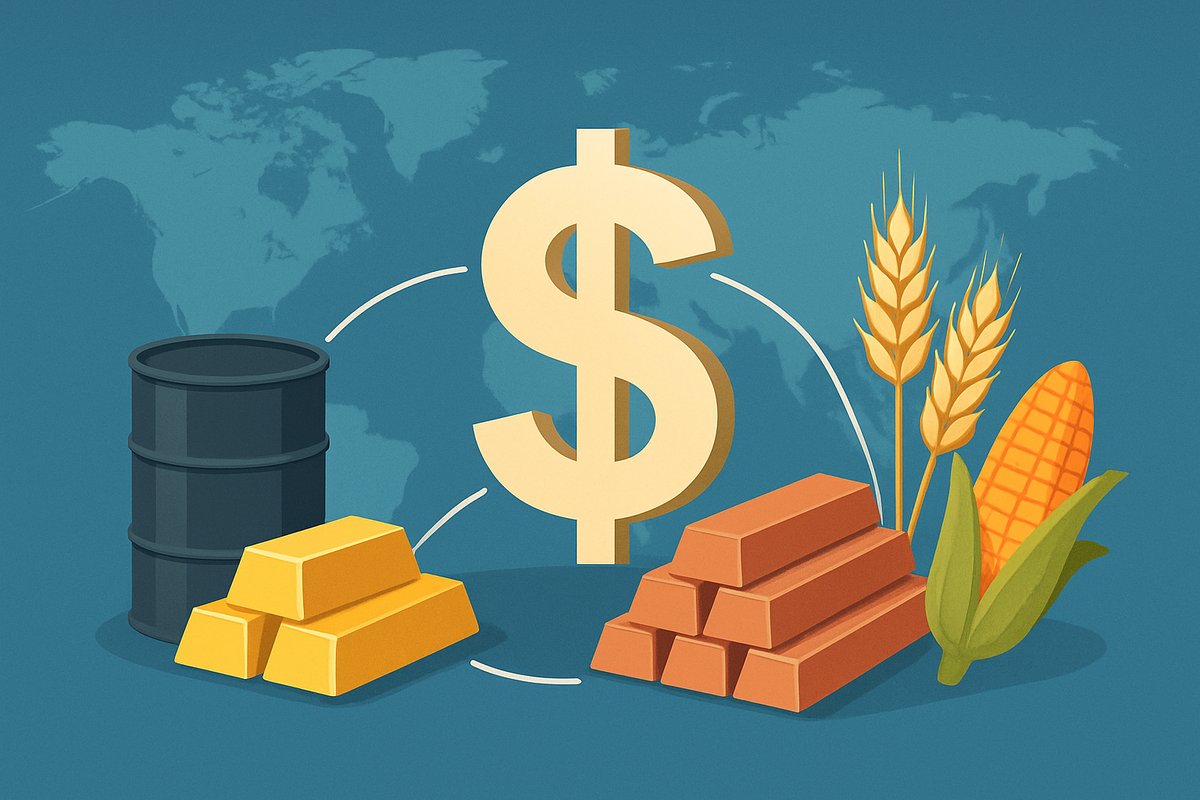
The global financial landscape is constantly shifting, but few dynamics are as consistently impactful as the intricate dance between major currency fluctuations and commodity trading. At the heart of this relationship lies the US dollar, the world's primary reserve currency and the dominant pricing mechanism for nearly all major commodities, from crude oil to gold, copper, and agricultural products. This unique position creates a powerful inverse correlation: a strengthening dollar typically makes commodities more expensive for international buyers, dampening demand and pushing prices down, while a weakening dollar has the opposite effect, making commodities cheaper and fueling price rallies.
This fundamental link has immediate and far-reaching implications across global markets. For traders, producers, and consumers alike, understanding the dollar's trajectory is paramount to navigating the volatile world of commodity markets. As the dollar strengthens, foreign buyers face higher costs, potentially leading to reduced demand and downward pressure on commodity prices. Conversely, a weaker dollar makes dollar-denominated commodities more affordable, stimulating demand and often driving prices higher. This dynamic influences everything from national trade balances to corporate profitability and the everyday cost of goods, making currency movements a critical factor in the health of the global economy.
The Greenback's Grip: Unpacking Recent Commodity Volatility
The current period, leading up to November 7, 2025, has seen a renewed focus on the US dollar's influence, particularly as global economic conditions remain in flux. While specific recent events are always unfolding, the overarching trend often revolves around the US Federal Reserve's monetary policy decisions and their subsequent impact on the dollar's strength. For instance, periods of aggressive interest rate hikes by the Federal Reserve tend to bolster the dollar, as higher yields attract global capital. This strength, in turn, has a palpable effect on commodity markets, often contributing to price corrections or sustained downward pressure.
Consider the ongoing narrative around inflation and central bank responses. If the Federal Reserve signals a more hawkish stance to combat persistent inflation, the dollar typically strengthens. This makes commodities like West Texas Intermediate (WTI) crude oil (NYMEX: CL=F) and benchmark gold (COMEX: GC=F) more expensive for purchasers holding euros, yen, or yuan. Consequently, demand from major importing nations, such as China, India, or Eurozone countries, can soften, leading to price declines even if underlying supply-demand fundamentals for the commodity itself are relatively stable.
Key players in this intricate dance include central banks, particularly the US Federal Reserve, whose policy statements are meticulously scrutinized by commodity traders and investors worldwide. Major commodity trading houses like Glencore (LSE: GLEN), Vitol, and Trafigura are acutely sensitive to these currency shifts, adjusting their hedging strategies and physical trade flows accordingly. Initial market reactions to significant dollar movements are often swift, with algorithmic trading exacerbating immediate price swings in futures markets for energy, metals, and agricultural products. For example, a sudden surge in the US Dollar Index (DXY) can trigger an immediate sell-off across various commodity classes, while a sharp decline can spark a broad-based rally, as investors anticipate cheaper imports and increased demand.
Winners and Losers: Corporate Fortunes Tied to the Dollar-Commodity Nexus
The ebb and flow of the US dollar against global currencies, and its subsequent impact on commodity prices, creates a distinct landscape of winners and losers among public companies. Companies involved in commodity production, particularly those with significant international sales and high operational costs in local currencies, often face a complex scenario. For instance, a strong US dollar typically translates to lower revenues when converted back to the local currency for a non-US mining company like Rio Tinto (ASX: RIO) or BHP Group (ASX: BHP), even if the dollar price of iron ore or copper remains stable. This is because their production costs are often in local currency, while their sales are in dollars, squeezing profit margins when the dollar is strong. Conversely, a weak dollar can significantly boost their profitability.
On the other hand, companies that are major importers of dollar-denominated commodities but sell their finished products in local currencies can see their input costs fluctuate dramatically. Airlines, for example, are major consumers of jet fuel, which is priced in US dollars. A strong dollar makes fuel purchases more expensive for non-US airlines such as Lufthansa (FWB: LHA) or Air France-KLM (EPA: AF), potentially eroding profit margins unless they can pass on costs through higher ticket prices. Similarly, manufacturers that rely on imported raw materials like industrial metals or chemicals will face higher input costs when the dollar strengthens, impacting their competitiveness.
Conversely, a weak dollar can be a boon for these same importers, lowering their cost base. For US-based commodity exporters, a weaker dollar makes their products more competitive on the global market, potentially increasing sales volumes and dollar-denominated revenues. Agricultural giants like Archer-Daniels-Midland (NYSE: ADM) or Bunge (NYSE: BG), which export vast quantities of soybeans, corn, and wheat, often benefit from a weaker dollar as it makes their US-produced goods more attractive to international buyers. Furthermore, companies that hold significant dollar-denominated debt but generate revenue in other currencies may find their debt servicing costs increase with a strong dollar, while a weak dollar eases that burden.
Broader Implications: Navigating Macroeconomic Currents
The interplay between currency fluctuations and commodity trading extends far beyond individual corporate balance sheets, weaving into broader industry trends, geopolitical dynamics, and regulatory considerations. The current environment, marked by ongoing debates about inflation, interest rates, and global economic growth, underscores the dollar's pivotal role. A sustained period of dollar strength can exacerbate inflationary pressures in countries that import significant dollar-priced commodities, potentially forcing their central banks to raise interest rates to defend their currencies and combat imported inflation, even if their domestic economies are fragile. This can lead to a global tightening of financial conditions, impacting capital flows and investment decisions worldwide.
Historically, periods of significant dollar strength or weakness have often correlated with major shifts in global economic power. For example, the commodity boom of the early 2000s, partly fueled by a weaker dollar and surging demand from emerging markets, significantly boosted the economies of commodity-exporting nations like Australia, Brazil, and Canada. Conversely, the "Taper Tantrum" of 2013, which saw the dollar strengthen on expectations of reduced quantitative easing, led to capital outflows from emerging markets and a softening of commodity prices. These historical precedents highlight how central bank communication and perceived shifts in monetary policy can trigger immediate and widespread market reactions, with ripple effects on everything from trade balances to sovereign debt levels.
Regulatory bodies and policymakers are constantly monitoring these dynamics. Governments of commodity-dependent nations often implement hedging strategies or build foreign exchange reserves to cushion against adverse currency movements. The ongoing discussions about de-dollarization in certain trade blocs, while nascent, reflect a desire by some nations to reduce their vulnerability to dollar fluctuations, potentially by increasing trade settlements in local currencies or through bilateral agreements. However, the deep liquidity and established infrastructure of dollar-denominated commodity markets mean that any significant shift would be a long-term, gradual process, making the dollar's influence paramount for the foreseeable future.
The Road Ahead: Anticipating Market Opportunities and Challenges
Looking ahead, the trajectory of the US dollar and its subsequent impact on commodity markets will remain a dominant theme for investors and businesses. In the short term, market participants will be closely watching upcoming inflation data, central bank meetings (especially from the Federal Reserve, European Central Bank, and Bank of Japan), and geopolitical developments that could influence safe-haven flows into or out of the dollar. Any unexpected shifts in these areas could trigger rapid repricing across commodity classes. For instance, a stronger-than-expected US jobs report or higher inflation figures could reinforce expectations of tighter monetary policy, strengthening the dollar and potentially pressuring commodity prices.
In the long term, the dynamics are more complex. The ongoing energy transition, geopolitical realignments, and evolving supply chains will introduce new variables. However, the fundamental inverse relationship between the dollar and commodities is likely to persist. Companies in the energy sector, such as ExxonMobil (NYSE: XOM) or Chevron (NYSE: CVX), will need to continue hedging against currency and commodity price volatility, while agricultural firms will have to adapt to changing global demand patterns influenced by currency strength. Strategic pivots might include diversifying revenue streams, optimizing operational costs in local currencies, or increasing focus on domestic markets to mitigate currency exposure.
Potential market opportunities could emerge for investors adept at identifying undervalued commodities during periods of dollar strength, anticipating a future dollar weakening cycle. Conversely, challenges include managing increased volatility and the risk of significant capital outflows from commodity-focused investments during prolonged periods of dollar appreciation. Scenarios range from a 'soft landing' for the global economy, where a moderately weaker dollar could support a broad commodity rally, to a 'hard landing' with a stronger dollar as a safe haven, leading to sustained commodity price weakness. Investors should prepare for continued volatility and focus on robust risk management strategies.
Concluding Thoughts: Navigating the Dollar-Commodity Conundrum
The intricate relationship between currency fluctuations, particularly the US dollar, and commodity trading is a cornerstone of global financial markets. As the world's primary reserve currency and the pricing benchmark for most commodities, the dollar's strength or weakness directly translates into significant impacts on prices, demand, and corporate profitability across various sectors. The inverse correlation remains a powerful force, influencing everything from the cost of oil for airlines to the export competitiveness of agricultural producers and the margins of global mining giants.
Moving forward, investors and businesses must remain vigilant, closely monitoring the US Federal Reserve's monetary policy, inflation trends, and broader macroeconomic indicators that drive dollar movements. The dollar's trajectory will continue to be a primary determinant of commodity market direction, creating both significant challenges and compelling opportunities. Understanding this fundamental dynamic is not merely an academic exercise; it is essential for strategic planning, risk management, and identifying potential investment avenues in the volatile yet vital world of commodities. The ability to anticipate and react to these currency-commodity shifts will be a key differentiator for success in the coming months.
This content is intended for informational purposes only and is not financial advice

















